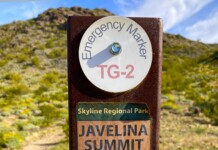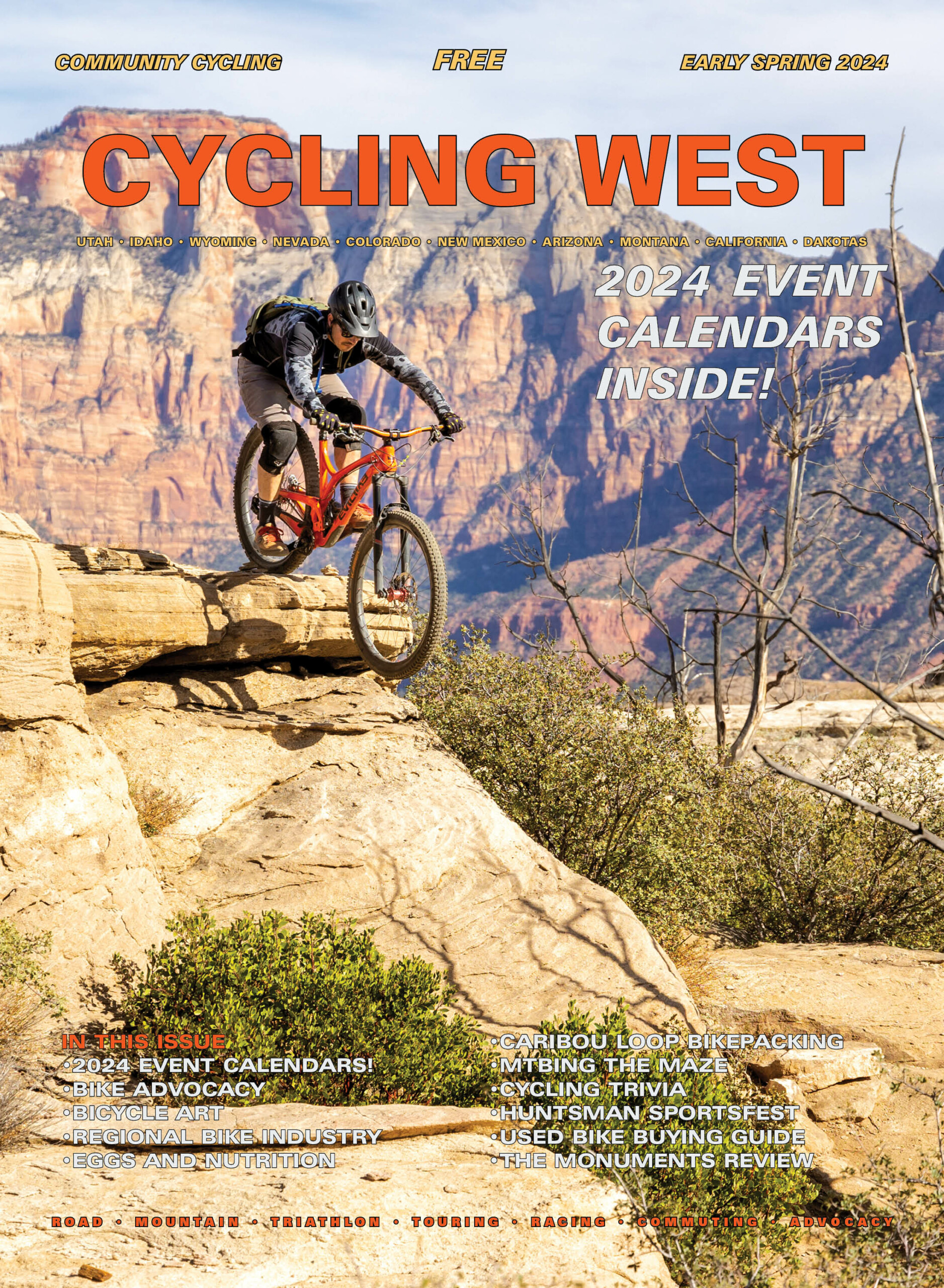By Lexi Dowdall — Care to plunge into one of the loneliest and most breathtaking corners of the National Park System? You’re about 100 miles from nowhere with nothing but an expansive labyrinth of sandstone to ogle and an arc of cerulean desert sky stretching above. The ultimate approach involves two wheels, several days, campsites of untold beauty, and over 80 miles of pedaling to unravel the astonishing beauty of the far-flung Maze District in Southern Utah’s Canyonlands National Park.
Comprising one of the four named districts of Canyonlands National Park on the Colorado Plateau, The Maze District is etched with a handful of the most remote dirt roads in the lower 48. Attracting only 1.5% of the park’s total visitors, the Maze offers zero amenities, requires complete self-sufficiency, and necessitates a high-clearance, 4WD vehicle. Crafted by wind and the relentless energy of rainwater seeking a path to the Colorado River, The Maze is a marvel 10 million years in the making. This 30-square-mile network of sandstone mesas, buttes, and towers is savagely divided by 5 major canyons and countless side canyons. Unparalleled solitude, rugged American wilderness and stunning rock art panels await those hardy enough to venture out.
I joined Utah-based Holiday River Expeditions in September 2023 for a fully guided, 5-day mountain biking trip on treacherous backroads to experience a facet of Utah that few are privileged to witness The challenging logistics and access make the quest an undertaking that most can’t commit to. Holiday provides guides, reserves campsites, obtains permits, prepares gourmet meals, and sends along one massively lifted 4WD support vehicle to keep riders’ loads light and provide mechanical assistance.
Within the Maze District, the Park Service has established just a few primitive campsites in the spirit of preserving the land. The titillating access road, the complete absence of services, and the isolated character of the place guarantee solitude. Per the Park’s mandates, the maximum commercial group size is limited to seven, plus two guides. I was nervous about joining the trip solo but figured anyone also crazy enough to pedal and hike 100 miles into the desert was probably worth knowing…
Day 1: Dropping In
On a pleasant September afternoon our newly minted group departed the Holiday River Expeditions base camp in Green River, Utah to head out. Way out. Three hours trickled away in the white company van trailed by our trusty sag wagon. We trundled from a bustling highway to country lanes to a hard scrabble dirt track. We eventually stopped at the secluded Hans Flat Ranger Station to display our permits and embark.
We pedaled west on Robbers’ Roost Flat while our cheerful guide Zoe piloted the support van behind us. The road earns its name from the nearby and infamous secret hideout of outlaw Butch Cassidy and his nefarious Wild Bunch Gang. After bouts of bank robbery, train heists, or stealing horses and rustling cattle the crew would retreat to Robber’s Roost Canyon to rest, restock and lay low. Several mild miles passed beneath our tires before the earth unceremoniously peeled away, leaving a vista of vast canyon country framed by gnarled piñon and juniper trees.
Shortly after shoving off, I noted the unruly racing of my mind, thoughts darting about like the ants scurrying along the flanks of the anthills I passed on my bicycle. My mind churned with a ceaseless parade of concerns regarding the future or past. I had yet to find myself in the present. I ruminated about the mileage of the trip, which seemed insurmountable. Would I even finish? I’d abandoned my comfort zone when we lost sight of the ranger station and frenetic misgivings hurtled through my mind, at odds with the desert’s stillness.
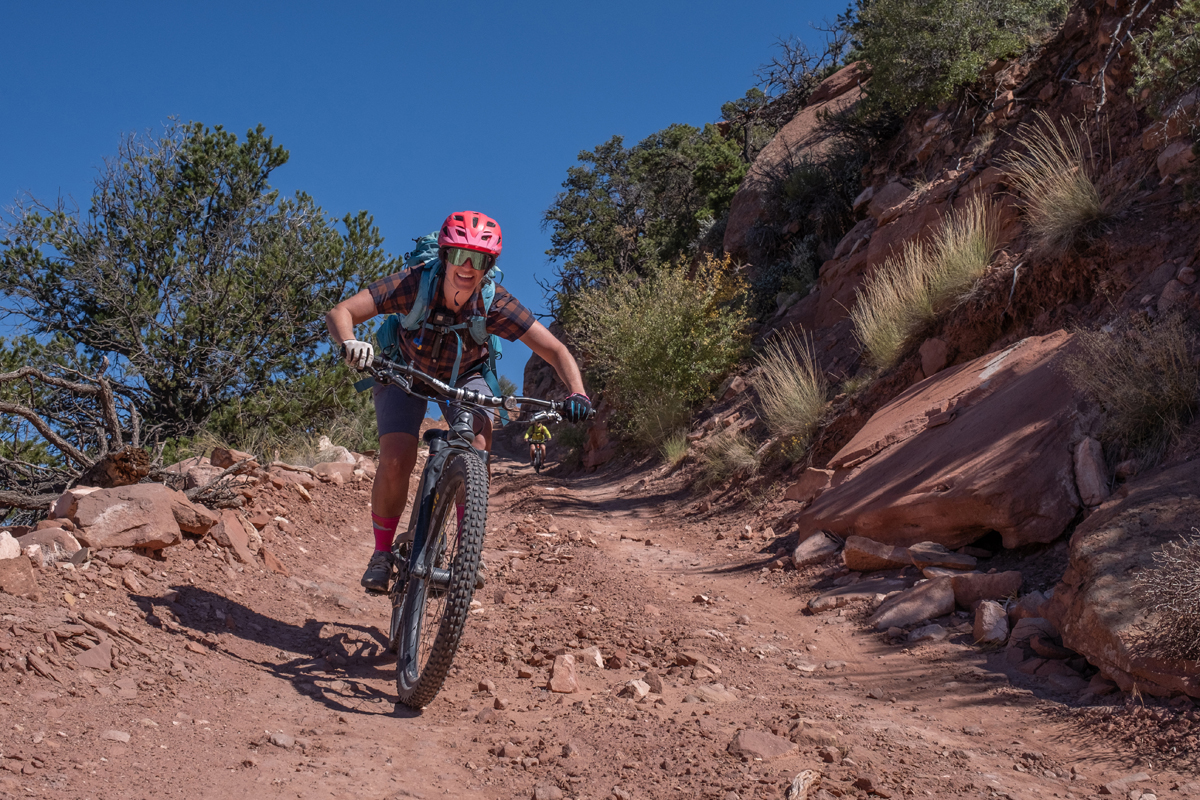
In short order, my attention shifted to the precipitous Flint Trail, the only path into the Maze District of Canyonlands National Park. Hardly a road, the one-lane track drops over 800 feet in a series of dizzying switchbacks sharper than a Ginsu knife. A worthy opponent for any high-clearance, rock crawling vehicle, I wondered how the van would survive as I gleefully juttered down rock gardens and ledges on my bicycle. Ben, our second stalwart guide, smartly executed multi-point turns to navigate the hairpin bends. Peering down, it was a wonder to behold the road snaking along the cliff’s face. The dramatic initiation was an appropriate preview for the staggering scenery that lay ahead.
Zoe eventually stopped us atop a mesa known as the Golden Stairs campsite. Afternoon sunlight bathed the expanse of Canyonlands beneath us. We all pitched our tents while Ben and Zoe began leisurely offering snacks and preparing dinner. We noshed on gourmet food as dusk fell and the vista before us shifted like a chameleon. The starry sky of Utah desert fosters quite an atmosphere to forge new friendships and I wearily plodded to my tent with a smile after sharing a few brews.
Day 2: AHHH-MAZED
I awoke to a chorus of coyotes and incandescent pink light above the dome of my tent followed by an encore of Ben and Zoe singing “Hoooooottt Cofffeeee!” Warm blueberry muffins, potatoes, bacon, and eggs soon filled our bellies. The entire crew opted to partake in a short hike for a closer look at the terrain sprawling beneath our camp. We sidled along slabs of rippled rock eroded by eons of time. Every known shade of red, scarlet, vermilion, and orange confronted our vision.
After our morning ramble, we straddled our bikes and prepared to cruise the mostly downhill route through Elaterite Basin and on into Canyonlands National Park to a coveted campsite at the Maze Overlook. Navigating Elaterite Basin is akin to taking a journey through time in an area that was once scattered with wind-deposited sand dunes around 200 million years ago in the Late Triassic. The area’s exotic name hails from elaterite, a rich brown hydrocarbon with a sticky, elastic texture that tends to seep out from cracks in the White Rim Sandstone deposits.
Ben delicately navigated shelves and waterfalls of solid rock littered with boulders behind the wheel of the van. My new friends and I waited gripped while the vehicle seemingly took a nose dive down a vertical drop-off. Tracing the landscape’s curves by bike was an exercise in meditation. We pedaled along ledges and slickrock that melted into to dry washes lined with candy-colored pebbles. The path was sinuous enough to remind me of the children’s game Candy Land. The jagged landscape and tough driving conditions delivered utter seclusion for our group to savor.
I snuck in a quick dirt nap as Zoe and Ben prepared a bountiful lunch in a dry wash. The bike gang finally pedaled up a gentle incline circling around Elaterite Butte, a towering cathedral of fine-grained Wingate Sandstone that rises 1,400 feet above the basin’s floor before one final swoop down to our home for the next two nights: The Maze Overlook. I’ve spent my entire life exploring Utah. I’ve seen plenty of red rocks; my parents first took me camping in Escalante at a tender 6 weeks of age. Nothing could prepare me for the dumfounding first glance of the Maze District. I ditched my bike in awe and walked to the edge to gape.
It’s not worth attempting to describe the multitude of convolutions, fins, and ramparts that comprise The Maze. Mere words cannot encompass the beauty, the complexity, the vast splendor that stretched beyond the horizon. Instead of wasting words on that futile exercise, I encourage you to start making plans to witness it yourself.
The Maze Overlook campsites are dramatically bound by Elaterite Butte and a vertiginous cliffside overlooking the stately Chocolate Drops formation. The Chocolate Drops are composed of thin columns of Organ Shale that rise nearly 200 feet above the surrounding landforms in an area known as The Land of Standing Rocks. That muddy brown layer of Organ Shale once coated Canyonlands National Park but the tenacious forces of nature have worn away nearly every vestige of this layer aside from a few tenacious pinnacles of red shale.
The rough-hewn canyons of the Maze District are studded with sandstone benches and standing rocks. Millions of years ago mud and sandy sediments accumulated at sea level in ancient seas, lakes, marches, salt flats, and sand dunes. The sediments lithified over time creating a varied layer cake of sedimentary rocks before tectonic action began heaving the entire region of the Colorado Plateau upward. The plateau was exposed to erosion and weathering by water, ice, frost, and wind alongside the powerful action of the Colorado and Green Rivers. Some rocks are more resistant than others and the layers erode at different rates which results in the creation of the outlandish landforms we can witness today.
We spent hours gawking at the landscape as afternoon shifted to evening and Zoe and Ben stuffed us with yet another hearty meal while the stars emerged.
Day 3: The Ancients
Dawn greeted us with cool hues the same ethereal blue as a juniper berry. Watching the sunrise bathe the silhouettes of the Chocolate Drops was nearly as satisfying as witnessing the drama of sunset casting golden light on the peculiar topography the evening prior. Staring at the Maze for more than a moment causes the brain to wonder and wander. The colors bloomed with the sun’s rise toward its zenith. I would have been content to spend the day just sitting and staring but Ben and Zoe had other plans…into the Maze we would go, a 600-foot plunge to the desert floor below us.
At first glance it seemed impossible, but Zoe and Ben expertly guided us down a nearly invisible route to the canyon’s floor. We traced steps carved out by the indigenous people who once traversed these canyons. It took us an hour to descend, and it felt like an entry into another world. We delicately navigated paths through cryptobiotic soil, crossed dry washes, and explored the canyon’s crenulations.
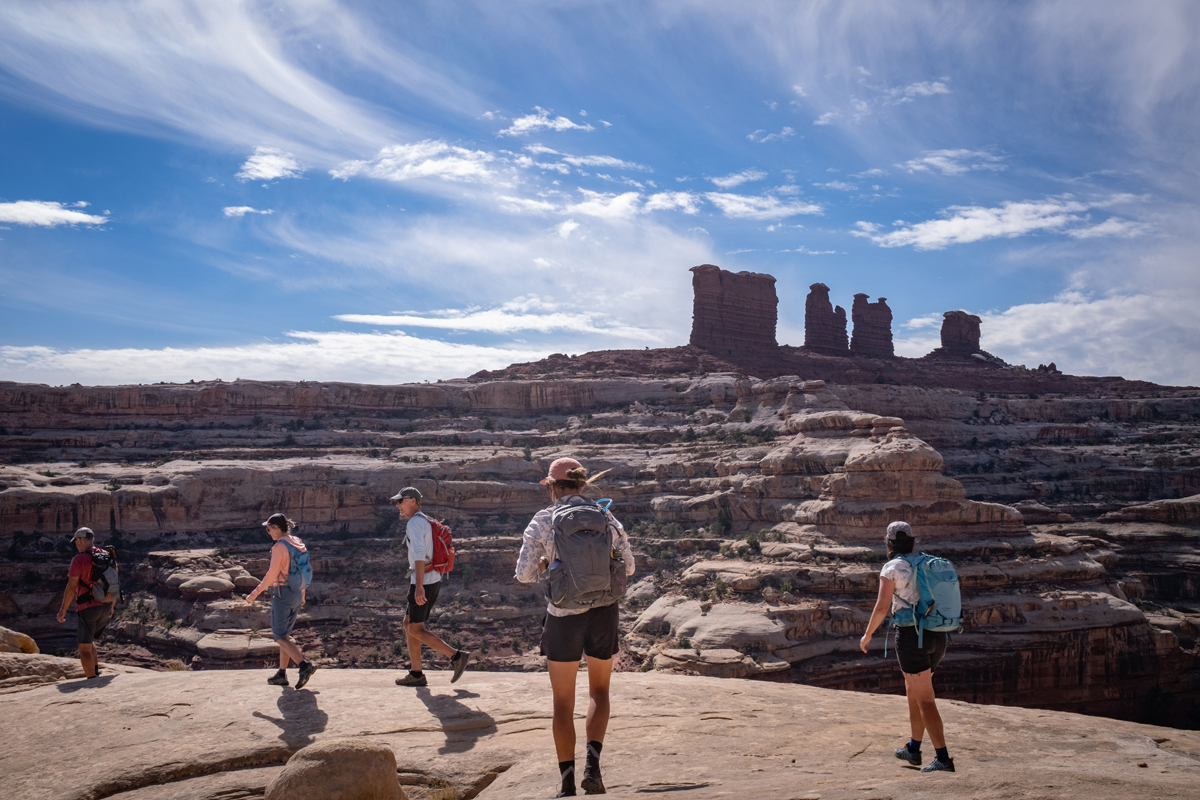
Rounding a wall of varnished sandstone the crew spied the most remarkable rock art panel I’d ever witnessed. The looming presence of many anthropomorphic figures was created by ancient people passing through the canyons between 2,000 to 4,000 years prior. Canyonlands itself has been inhabited by humans for over 10,000 years and the area’s rock art is characterized as Barrier Canyon Style. It is hypothesized that artists belonging to the Desert Archaic Culture, which dwelled in the area from 8000 B.C. through 500 A.D., created the panels in Canyonlands and neighboring Horseshoe Canyon.
It was impossible to peer upon this edifice and not ponder time, humanity, and mortality. Rice grass sprouting from an extended palm, wide eyes, fluttering birds, lightning, and snakes spangled the wall. The illusion of solitude and pristine wilderness was shattered by the traces of those whose old stories are also a part of this landscape.
We relaxed in the shade for lunch and took in the handiwork of the ancients. A quiet, reflective hike back to our camp was capped by the adventure of climbing back up and out. We’d only tasted the Maze District and it was inconceivable to imagine what other wonders could await a traveler willing to spend a few more days, a week, a month out there.
Day 4: The Outback
Light slowly filled the vista each morning like water. On the horizon, silhouettes of distant buttes, towers, buttresses, and mountains slowly emerged in a layered tapestry. We oiled our chains after Zoe and Ben’s hearty breakfast and shoved off to tackle our biggest chunk of miles yet. The undulating miles, occasionally littered with rock gardens, were made less tiresome by chatting to my trip companions, now true friends.
A noteworthy uphill grind was required of us and the van as we backtracked out of the Maze District. There was much gratitude for Zoe and Ben who had performed this feat numerous times. We all agreed this place was utterly inaccessible without their help and expertise. We pedaled up the declivity that had led us to the previous two days of wonder, huffing and puffing all the while.
We then turned east following the contour of a large bluff, occasionally peeking back to the north at the labyrinth which had captivated us. The La Sal Mountain Range towering over Moab unfurled to the north and the desert tipped away beneath us, revealing yet more canyons, mesas, and monoliths.
Zoe and Ben insisted we ditch the bikes for a short hike to another impressive ancient rock art panel. It was impossible not to feel profound reverence for the history of these canyons. The eyes of the figures peered out at us with a prescient knowing. It was a gift to see them in such a remote place, powered only by our legs and bicycles.
Our final night included camping on BLM-managed land. Zoe and Ben were thrilled about scoring a site perched far above the Colorado River raging through the depths of Cataract Canyon. The moon rose as we savored steaks and I opted to sleep out on the rock sans tent. The deep silence of the desert accompanied unparalleled stargazing and the thrill of witnessing a shooting star or two as I drifted off.
Day 5: The Gift of Presence
For our final day on bikes, we would descend to the elevation of Lake Powell while riding around several of the canyons that feed the whitewater rapids of lower Cataract Canyon. The route gradually revealed the hulking Henry Mountain Range framed by stark red rock buttes. The pace was gentle and slow, conducive to reflecting on all that we’d seen and trading jokes with my fellow riders.
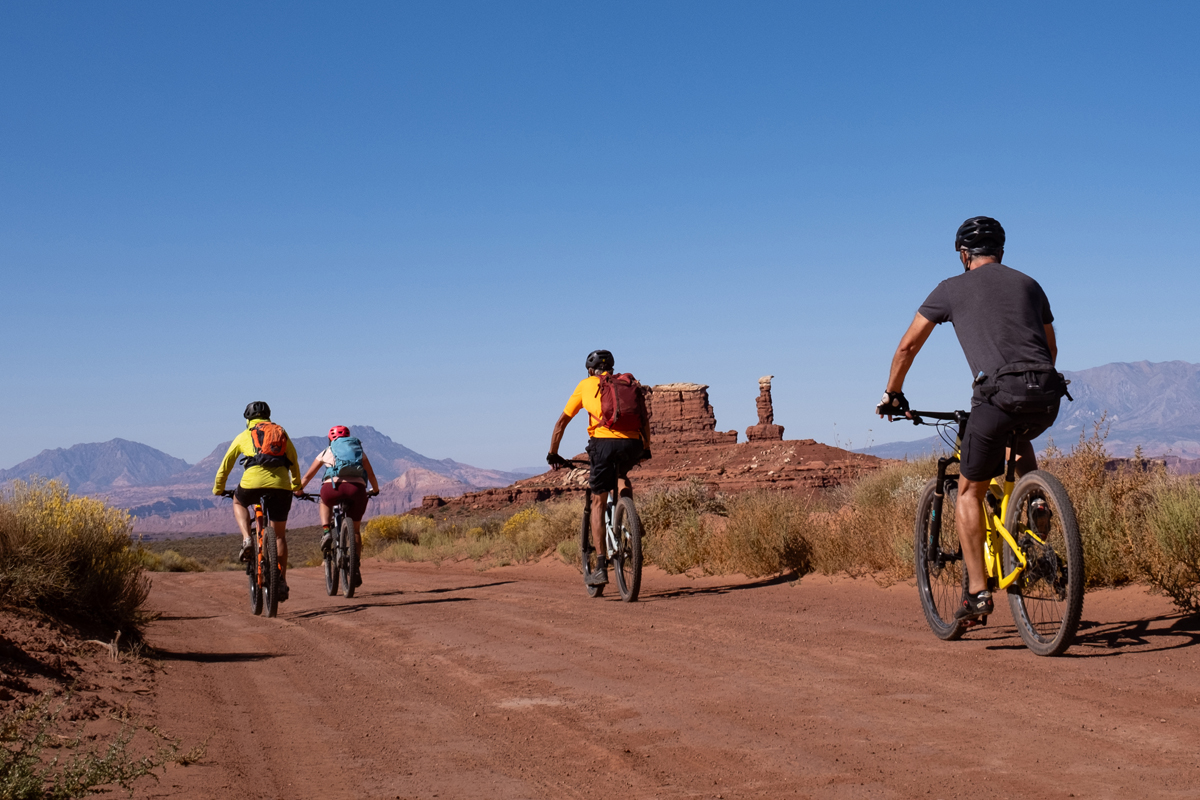
Throughout these final miles, entire minutes would pass without the chaotic flood of disconnected thoughts I’d weathered on the first few tentative miles of day one. No hashing on the past, no concerns about the future. Just presence. Alive in the methodical pace of rolling tires, good company, and the majestic scenery surrounding us. To be present was the simple parting gift of this trip.
If You Go:
- Due to the complexity and remoteness of this itinerary, it is highly recommended to book a trip with an outfitter like Holiday River Expeditions that can manage logistics, provide transport, and obtain permits. Holiday runs bike trips to the White Rim Trail and the Maze District in April, May, and September. More info and bookings at: https://www.bikeraft.com
- This trip is suitable for strong intermediate and advanced riders. In total you can expect to pedal 80 miles in 4-5 days ranging from 12 miles per day to 25. There are options to add day hikes or short bike rides in addition to the daily road mileage. There are sections of steep, technical, and rocky terrain, but most of the mileage takes place on graded dirt roads. It is possible to hop off and walk your bicycle down any feature that feels too daunting.
- If you go unsupported, you’ll need to book campsites well in advance. Permits and fees are required to enter the Maze District via the Hans Flat Ranger outpost. As there is no potable water along the route, it is highly recommended to bring a support vehicle. Regarding vehicles, it is imperative to have a high-clearance, 4WD vehicle to navigate the rugged roads in the area. You’ll want a full-suspension mountain bike in great working order with plenty of spare parts to address any mechanical issues to enjoy this trip. Visit https://www.nps.gov/cany/index.htm for more information about Canyonlands National Park.
- Check the weather to inform your packing decisions. The desert can often be cold at night and storms arrive quickly so you should plan on a jacket and rain gear despite the heat. There are zero amenities and services in the Maze District, you’ll need to carry all your food and water. Maps and GPS will assist navigation and a satellite phone is recommended as cell service is spotty or nonexistent. Ensure your bike is in excellent working order and carry plenty of spare parts and tools.
- If possible, plan to spend more than one night at the Maze Overlook. The stunning landscape and chance to hike and relax around one of the National Park System’s most scenic campsites should motivate you to stay a while.

